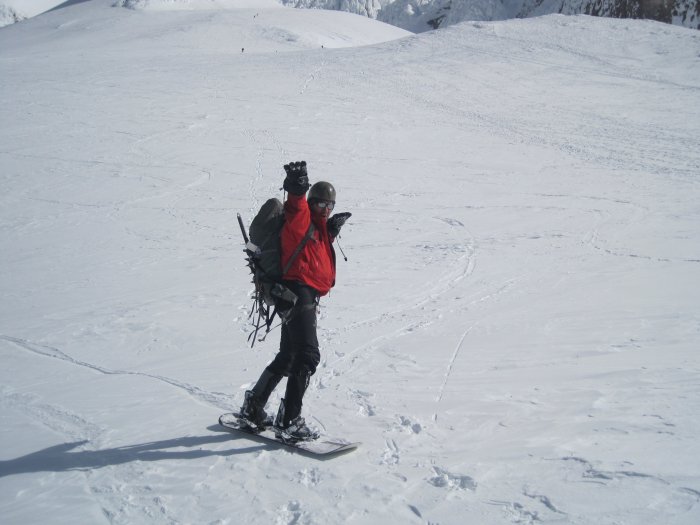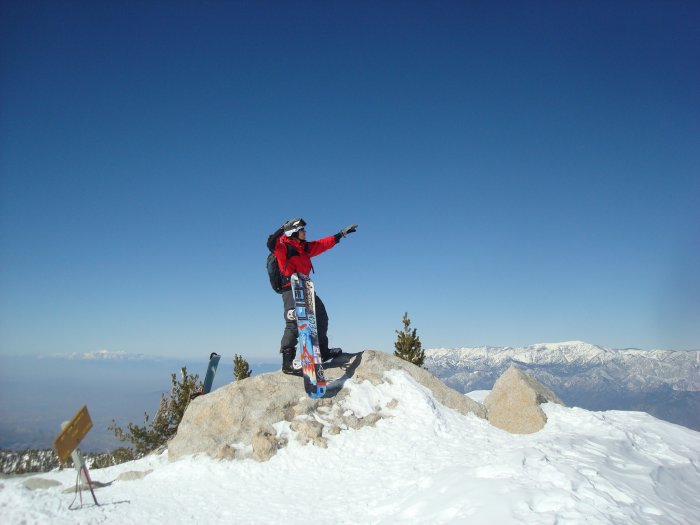The SoCal Triple Crown: Shredding the Range Highpoints

It is well established: Punishment=Glory. But the glory usually comes at the summit; we seldom experience glory on the route’s descent. Backcountry snowboarding is an exception. Hours of work on the climb up = minutes of joy on the ride down.
I first begun looking for more exciting ways down mountains several years ago. I loved climbing up but hated the long trek down. My first solution was taking up paragliding: light enough to carry up easy peaks, and very quick to come down. However halfway through my training towards my paragliding pilot’s license I had a close call, a small wreck that left me shaken up, though not seriously injured. Soon after my two best pilot friends suffered in turn a broken ankle and a compressed spine. My instructor couldn’t fly anymore after an accident where he was hung up in electrical wires. I decided to give up paragliding and learn a different way down.
That winter I took up snowboarding. By my second season, the winter of ‘09-’10, there was some epic snowfall in SoCal and I was good enough to brave the backcountry. Riding the slopes is a SoCal establishment and there is the really excellent mountain riding here... But you have to time it right. Our mountains are big and steep, but the snow only stays a little while after the storm, so you gotta take full advantage. It doesn't rain much here, which also means rare snows in the mountains. SoCal’s mountains are not world famous, but they are certainly respectable, including 2 of the 7 most prominent peaks in the continental USA, San Jacinto and San Gorgonio. Along with Mt Baldy, these three peaks are the monarchs of SoCal’s three major ranges, and all worthy snowboarding objectives. The SoCal Triple Crown.
But first, I had to make my debut on something a little less intimidating. With all the snow, Cuyamaca, San Diego county’s high point at 6,500’ was my first target. In a good snow year (like last season) there is enough snow on Cuyamaca to snowboard the fire road. I went alone. Fortunately my friend Austin and his buddy Jake were snowshoeing that day and I met them on the summit. That gave me a lot of courage, knowing somebody would at least readily identify the body. On the ride downI was very scared and conservative (remember it was my first time in the backcountry), but it was so much better than being in-bounds! 3 miles of a narrow green -or in the steepest places blue- chalked up to an hour hike up and a 15 minute ride down, and I was hooked on shredding the backcountry gnar. Total trip time car-to-car under 1:30. Enough time left in the day to go for a surf back in La Jolla.
Now, with my backcountry vibe on, it was time to get serious: San Jacinto (San J) has a 10,000 foot north face that rises in only 5 horizontal miles; in late winter and springtime this is a prime mountaineering objective. My Seattle friend Skye saw it as a prime midwinter ski objective, given the bad Pacific Northwest snow last year. So he flew down and we headed out from San Diego at midnight on the drive to San J and its famous Snow Creek route. Staying well away from the caretaker house we added lots of time going through a boulder field. But the problems really came when the snow was so low down as to obscure the cairns on the route. In one critical 1-mile section there is a path ("tunnel") amongst the bushes that without finding it, most parties turn around. The copious snow meant we never found it and instead made our way on top of snow-covered heinous bushes for hours. By the time we got to the base of the 6000’ snow tongue, we had been out almost 12 hours. But we pressed onward, around massivebottomless crevasses (are they called crevasses if it's not a glacier?) and eventually up very loose sugar snow that steepened to 50 degrees at the top. 22 hours after starting we then summited; then bivyied in a snow cave we made. Once the sun came up we could see the hut (it was almost completely buried in snow) and grabbed a few hours of sleep there.
There, late morning we awoke to perfect corn snow on the San J summit and then 6000’ of amazing powder on the ride down. The joy cannot be captured, even though only 20 minutes of riding brought us all the way to the bottom of the ride-able snow. Climbing this route in early February is not recommended, though this is definitely the best time to descend it. Starting at 50 degrees and quickly mellowing to 40 and then slowly easing up, the Snow Creek Couloir is actually quite wide. Only the bottom, shady part was hard and full of avalanche debris. I was initially scared by the steepness at the top, but the powder was so deep that it was safe. After that, it was a semi-heinous hike out (we were able to follow the tunnel for part of the way) before bailing to the desert and Joshua Tree for the rest of the week…car to car was 40 hours on that one…
The last shredded summit of the season was Oregon’s Mt. Hood. Konstantin and I joined Dima, Skye, and others from the Northwest to summit and then shred this most beautiful peak in April 2010. Though its famed for its year-round skiing, the truth it that it does not compare to SoCal after a storm…volcanoes are not steep enough! But still a very enjoyable ride down after the initial icy couloir. A perfect end to my first backcountry season.
By January 2011, it seemed like this was going to be another epic snow year in SoCal and I quickly resumed my objective for the triple crown. The first weekend after new years I headed with Andre to San Gorgonio (San G), high point of the deep San Bernardino range and indeed all of SoCal at 11,500.’ 17 Miles round trip means it’s not a usual snowboard destination- too much of a hike-in. But it does have steepness once you make the trek in.
Andre skinned in on skis but I had to use snowshoes and carry my board. The flat trail the first few miles has so-so coverage even recently after the storm, but that also means we made good time. After that we made about 1 mile an hour for the last few miles as the snow got deeper. The summit plateau was terribly icy and windy (as were the other faces- only the sun drenched south face was ride-able) and painful to proceed (and descend), but once off of the summit plateau riding was much fun. The upper mountain indeed gets steep enough- maybe 30 degrees or more, to have some very enjoyable riding. For several miles of descent we generally had several inches of windblown powder and corn.
The first four miles of descent had good downhill, a bit of traversing and a few necessary step-outs. Eventually, for the last few flat and thinly covered miles I had to step out walk a lot. But still, when whenever the coverage returned to sufficient I put the board back on and shredded to the car, for a round trip time of 10 hours and exactly all of the daylight minutes. While it seemed like it would be a big year, I’m lucky to seize on the chance to go then; in this La Nina year we didn’t see snow again till the end of February.
The smallest but most trodden of the SoCal giants is Mt Baldy (also known as San Antonio, 10,000’), mostly because it’s right outside of Los Angeles. The San Gabriel range’s high point, it’s also the most famous ski mountain in SoCal. It has a commercial resort, as well as a well known 2000’ backcountry bowl that steepens to around 45 degrees near the top. It’s the West’s almost exact equivalent of Tuckerman ravine, albeit only in a good snow year. Baldy Bowl, as its called, even has a Sierra Club skiers hut.
My first try of Baldy Bowl was this February with Mark, but a snow dearth following our December hammering meant the mountain hadn’t seen snow in more than a month. The snow was old hard and icy and the bowl didn’t even have full coverage- a heinous situation because there is no runout after the slope- just rocks, looming below hard packed dirty snow. Good firm snow conditions for climbing meant it was still a fun and beautiful (and fast) summit and return to car in 4:30, but we elected to not snowboard down in such conditions. I’d have to wait for more snow. It’d be safer and a lot more fun. Such a scenario illustrates the necessity of good timing for SoCal backcountry.
Then, late February received two consecutive big storms. These dumped 3 more feet of snow and early March was looking good for Baldy Bowl. This time I went with Dallas, and the snow slowed our ascent substantially. But there was full coverage, end even though we were day 3 after the storm, there was a ton of virgin snow in the bowl. The summit to the bowl’s lip was a quick fun warmup, then the 40-degree drop into the bowl and a 3-minute ride to the bottom with perfect s-turns in nice corn. 5 stars out of 5! Baldy Bowl is justifiably famous. I was just sorry I didn't have time to do another lap...
However the lower mountain was already melting out and there were lot of bare patches. It’d be worth staying up at the cabin one weekend of a good storm and doing laps down different chutes in the bowl…but amazingly, only 3 days after the huge storm it was no good to ride lower than the bowl. A necessary walkout meant 6 hours car-to-car. Back at the car, with the SoCal Triple Crown complete Ibegan to ponder what else there is to shred in the California backcountry, and Sierra plans immediately began churning in my head...









































